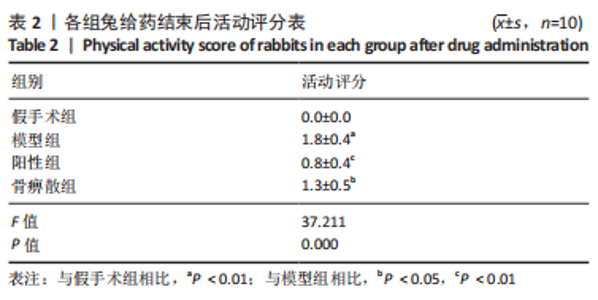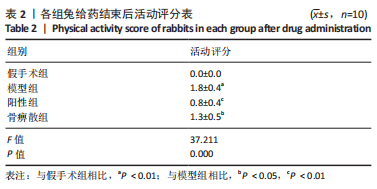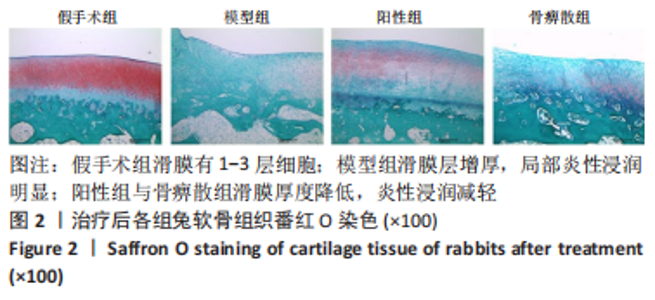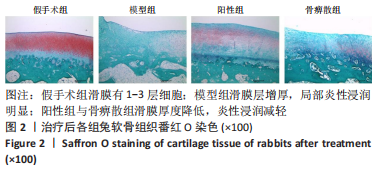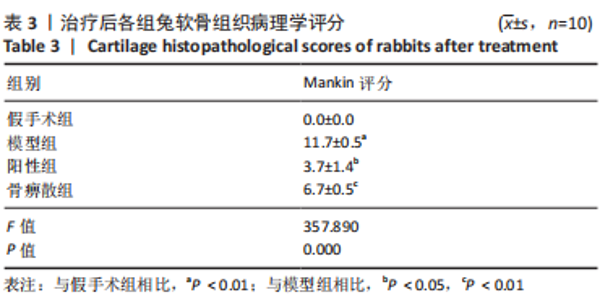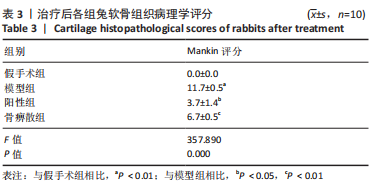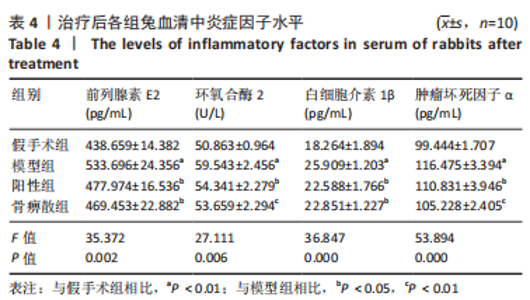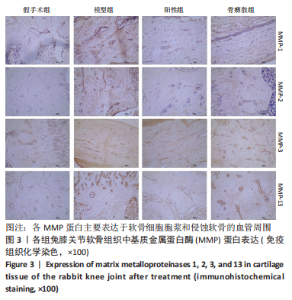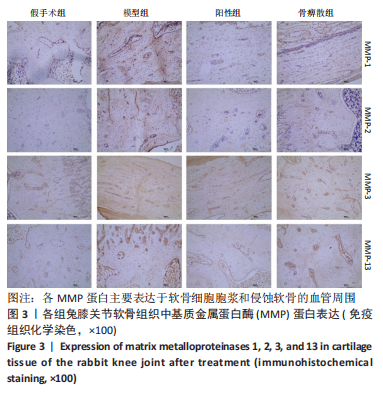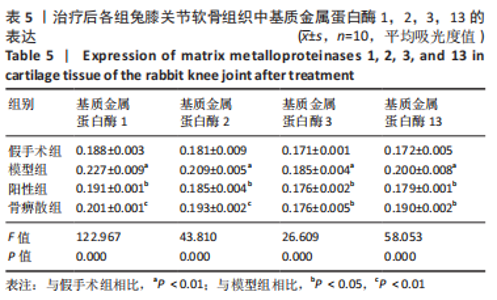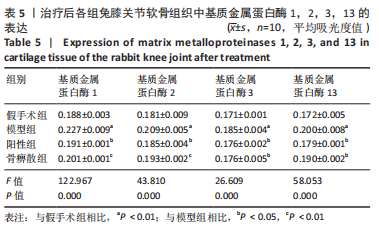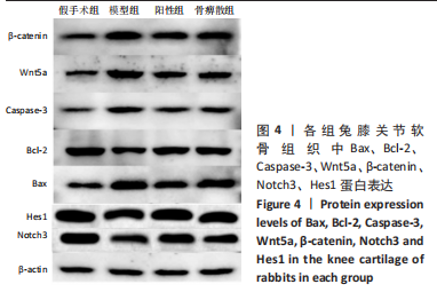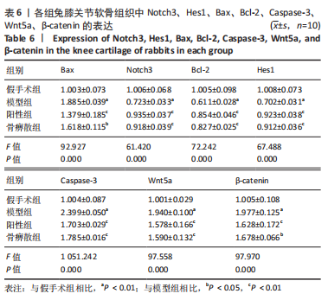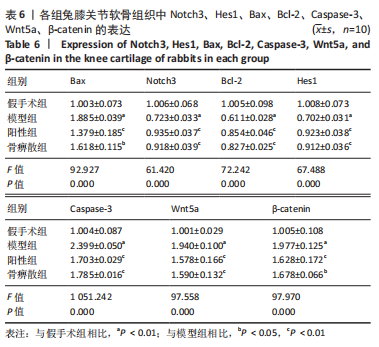Chinese Journal of Tissue Engineering Research ›› 2023, Vol. 27 ›› Issue (35): 5622-5627.doi: 10.12307/2023.812
Previous Articles Next Articles
Effects of Gubi Powder on cartilage tissue-related signaling pathways in rabbits with knee osteoarthritis
Li Dongdong1, Chen Guangyou1, Li Xiaoming2, Wu Xuelian2, Zhu Kai1, Lei Yang1, Yi Lu1
- 1Department of Orthopedics and Traumatology, Affiliated Hospital of Traditional Chinese Medicine, Southwest Medical University, Luzhou 646000, Sichuan Province, China; 2Department of Rehabilitation Medicine, Southwest Medical University, Luzhou 646000, Sichuan Province, China
-
Received:2022-08-16Accepted:2022-10-27Online:2023-12-18Published:2023-06-02 -
Contact:Chen Guangyou, MD, Associate professor, Associate chief physician, Department of Orthopedics and Traumatology, Affiliated Hospital of Traditional Chinese Medicine, Southwest Medical University, Luzhou 646000, Sichuan Province, China -
About author:Li Dongdong, Master, Attending physician, Department of Orthopedics and Traumatology, Affiliated Hospital of Traditional Chinese Medicine, Southwest Medical University, Luzhou 646000, Sichuan Province, China -
Supported by:Project of the Affiliated Hospital of Traditional Chinese Medicine, Southwest Medical University, No. 2018XYLH-019 (to CGY)
CLC Number:
Cite this article
Li Dongdong, Chen Guangyou, Li Xiaoming, Wu Xuelian, Zhu Kai, Lei Yang, Yi Lu. Effects of Gubi Powder on cartilage tissue-related signaling pathways in rabbits with knee osteoarthritis[J]. Chinese Journal of Tissue Engineering Research, 2023, 27(35): 5622-5627.
share this article
Add to citation manager EndNote|Reference Manager|ProCite|BibTeX|RefWorks

2.3 各组兔膝关节软骨组织病理形态 假手术组关节软骨结构完整,关节软骨结构分层清晰,未见明显潮线,软骨细胞分布均匀,软骨内无血管和神经,未见明显软骨缺损、软骨细胞坏死及纤维增生等病理改变;模型组可见局部软骨面缺损,缺损区域软骨细胞显著减少,大量软骨细胞坏死,软骨层明显变薄甚至丢失,缺失区域大量纤维组织增生,可见较多胶原纤维以及核呈长梭形的纤维细胞;阳性组可见局部软骨面缺损,软骨细胞排列紊乱,软骨细胞数量减少,软骨细胞坏死,部分软骨层丢失,缺失区域存在纤维组织增生情况,可见较多胶原纤维和纤维细胞,未见明显炎性细胞浸润;骨痹散组可见局部软骨面不同程度缺损,软骨细胞数量减少,部分软骨层丢失,多量纤维组织增生,可见较多胶原纤维和纤维细胞,未见明显炎性细胞浸润,见图1,2和表3。"

| [1] BEARD DJ, DAVIES LJ, COOK JA, et al. The clinical and cost-effectiveness of total versus partial knee replacement in patients with medial compartment osteoarthritis (TOPKAT): 5-year outcomes of a randomised controlled trial. Lancet. 2019;394(10200):746-756. [2] YIN Z, QIAN P, WU X, et al. Unicondylar knee arthroplasty versus total knee arthroplasty in adults with isolated medial osteoarthritis: A matched study protocol. Medicine (Baltimore). 2020;99(35):e21868. [3] 霍少川,王海彬,唐宏宇,等.补肾健脾活血中药干预膝骨关节炎模型大鼠软骨细胞IL-1β/ERRα/SOX9/Col2α1信号通路的变化[J].中国组织工程研究,2020,24(35):5577-5581. [4] 夏璇,王焕锐,吕媛,等.痹祺胶囊治疗膝骨关节炎的临床疗效及影像学评价[J].中草药,2020,51(13):3518-3522. [5] JUNG JH, IKEDA G, TADA Y, et al. miR-106a-363 cluster in extracellular vesicles promotes endogenous myocardial repair via Notch3 pathway in ischemic heart injury. Basic Res Cardiol. 2021;116(1):19. [6] LUO X, ZHANG L, HAN GD, et al. MDM2 inhibition improves cisplatin-induced renal injury in mice via inactivation of Notch/hes1 signaling pathway. Hum Exp Toxicol. 2021;40(2):369-379. [7] 朱星昊,陈亚楠,魏丹丹,等.七味红花殊胜丸对肝纤维化小鼠Notch/Hes1信号通路的影响[J].中国医院药学杂志,2021,41(1):8-12. [8] 岳宗进,刘汝银,于露,等.牛膝多糖通过Notch1通路影响骨髓间充质干细胞向髓核样细胞分化的机制[J].西安交通大学学报(医学版), 2022,43(4):600-606. [9] 曾凡,陈柏屹,王康,等.加味独活寄生合剂对膝骨关节炎模型兔膝关节软骨组织细胞自噬及凋亡相关蛋白的影响[J].中医杂志,2022,63(8): 773-780. [10] GUERMAZI A, NEOGI T, KATZ JN, et al. Intra-articular Corticosteroid Injections for the Treatment of Hip and Knee Osteoarthritis-related Pain: Considerations and Controversies with a Focus on Imaging-Radiology Scientific Expert Panel. Radiology. 2020;297(3):503-512. [11] 冀海军,张永红.阳和汤含药血清对膝骨性关节炎兔膝软骨MMP-1,MMP-3和TIMP-1表达的影响[J].四川中医,2020,38(3):72-76. [12] 陶金刚,黄媛霞.右归丸联合美洛昔康治疗膝骨性关节炎的临床研究[J].现代药物与临床,2020,35(10):2057-2062. [13] ARDEN NK, PERRY TA, BANNURU RR, et al. Non-surgical management of knee osteoarthritis: comparison of ESCEO and OARSI 2019 guidelines. Nat Rev Rheumatol. 2021;17(1):59-66. [14] CHEN Y, WU YY, SI HB, et al. Mechanistic insights into AMPK-SIRT3 positive feedback loop-mediated chondrocyte mitochondrial quality control in osteoarthritis pathogenesis. Pharmacol Res. 2021;166:105497. [15] WU X, CAI Y, LU S, et al. Intra-articular Injection of Chloramphenicol Reduces Articular Cartilage Degeneration in a Rabbit Model of Osteoarthritis. Clin Orthop Relat Res. 2019;477(12):2785-2797. [16] 孙立平,周霞,刘炬,等.从调控血管内皮生长因子及其受体激活Notch信号通路角度探讨生地梓醇促血管新生及神经功能重塑作用[J].实用心脑肺血管病杂志,2021,29(11):63-68. [17] 韩莎莎,张贺鹏,李跃峰.玻璃体腔注射TA对光化学诱导大鼠BRVO模型血管生成及Notch通路的影响[J].国际眼科杂志,2020,20(6):951-955. [18] TURHAN Y, ARICAN M, KARADUMAN ZO, et al. Chondroprotective effect of Nigella sativa oil in the early stages of osteoarthritis: an experimental study in rabbits. J Musculoskelet Neuronal Interact. 2019;19(3):362-369. [19] ZIPPORAH E B, PATRA B, GOVARTHANAN K, et al.Defective cell proliferation is an attribute of overexpressed Notch1 receptor and impaired autophagy in Fanconi Anemia. Genomics. 2020;112(6):4628-4639. [20] LEE YC, CHUNG CP, CHANG MH, et al. NOTCH3 cysteine-altering variant is an important risk factor for stroke in the Taiwanese population. Neurology. 2020;94(1):e87-e96. [21] 陈谱,阮安民,周俊,等.通络止痛凝胶对不同程度膝关节骨性关节炎家兔滑膜炎性程度的影响[J].北京中医药大学学报,2020,43(12):1011-1017. [22] 杨少辉,许红霞,孙卫强,等.杯苋甾酮通过上调miR-204表达抑制IL-1β诱导的软骨细胞凋亡的实验研究[J].河北医学,2021,27(3):368-374. [23] AN Y, WAN G, TAO J, et al. Down-regulation of microRNA-203a suppresses IL-1β-induced inflammation and cartilage degradation in human chondrocytes through Smad3 signaling. Biosci Rep. 2020;40(3):BSR20192723. [24] TIMUR UT, CARON MMJ, JEUKEN RM, et al. Chondroprotective Actions of Selective COX-2 Inhibitors In Vivo: A Systematic Review. Int J Mol Sci. 2020; 21(18):6962. [25] KAJINO-SAKAMOTO R, FUJISHITA T, TAKETO MM, et al. Synthetic lethality between MyD88 loss and mutations in Wnt/β-catenin pathway in intestinal tumor epithelial cells. Oncogene. 2021;40(2):408-420. [26] BARTOLETTI G, DONG C, UMAR M, et al. Pdgfra regulates multipotent cell differentiation towards chondrocytes via inhibiting Wnt9a/beta-catenin pathway during chondrocranial cartilage development. Dev Biol. 2020; 466(1-2):36-46. [27] 李慧,马玉环,许丽梅,等.独活寄生汤拆方通过Wnt/β-catenin信号通路抑制软骨细胞炎症反应[J].中国组织工程研究,2020,24(35):5589-5594. [28] XIA C, WANG P, FANG L, et al. Activation of β-catenin in Col2-expressing chondrocytes leads to osteoarthritis-like defects in hip joint. J Cell Physiol. 2019;234(10):18535-18543. [29] MA L, LIU Y, ZHAO X, et al. Rapamycin attenuates articular cartilage degeneration by inhibiting β-catenin in a murine model of osteoarthritis. Connect Tissue Res. 2019;60(5):452-462. [30] 冯玮,谢正松,罗岑,等.过表达Notch配体Delta-like基因的MLO-Y4骨细胞株的建立及其对骨髓基质细胞成骨分化的作用[J].第三军医大学学报,2020,42(9):899-907. [31] SZEMES M, MELEGH Z, BELLAMY J, et al. A Wnt-BMP4 Signaling Axis Induces MSX and NOTCH Proteins and Promotes Growth Suppression and Differentiation in Neuroblastoma. Cells. 2020;9(3):783. [32] ESMAIL MM, SAEED NM, MICHEL HE, et al. The ameliorative effect of niclosamide on bile duct ligation induced liver fibrosis via suppression of NOTCH and Wnt pathways. Toxicol Lett. 2021;347:23-35. |
| [1] | Li Yongjie, Fu Shenyu, Xia Yuan, Zhang Dakuan, Liu Hongju. Correlation of knee extensor muscle strength and spatiotemporal gait parameters with peak knee flexion/adduction moment in female patients with knee osteoarthritis [J]. Chinese Journal of Tissue Engineering Research, 2024, 28(9): 1354-1358. |
| [2] | Du Changling, Shi Hui, Zhang Shoutao, Meng Tao, Liu Dong, Li Jian, Cao Heng, Xu Chuang. Efficacy and safety of different applications of tranexamic acid in high tibial osteotomy [J]. Chinese Journal of Tissue Engineering Research, 2024, 28(9): 1409-1413. |
| [3] | Huang Xiarong, Hu Lizhi, Sun Guanghua, Peng Xinke, Liao Ying, Liao Yuan, Liu Jing, Yin Linwei, Zhong Peirui, Peng Ting, Zhou Jun, Qu Mengjian. Effect of electroacupuncture on the expression of P53 and P21 in articular cartilage and subchondral bone of aged rats with knee osteoarthritis [J]. Chinese Journal of Tissue Engineering Research, 2024, 28(8): 1174-1179. |
| [4] | Zhang Zeyi, Yang Yimin, Li Wenyan, Zhang Meizhen. Effect of foot progression angle on lower extremity kinetics of knee osteoarthritis patients of different ages: a systematic review and meta-analysis [J]. Chinese Journal of Tissue Engineering Research, 2024, 28(6): 968-975. |
| [5] | Hu Zhixing, Li Qun, Yang Chao, Wang Xiaoxiao, Fang Luochangting, Hou Wuqiong, Lin Na, Chen Weiheng, Liu Chunfang, Lin Ya. Network meta-analysis of the modeling effects of different factors on rabbit models of steroid-induced osteonecrosis of femoral head [J]. Chinese Journal of Tissue Engineering Research, 2024, 28(6): 976-984. |
| [6] | Shen Feiyan, Yao Jixiang, Su Shanshan, Zhao Zhongmin, Tang Weidong. Knockdown of circRNA WD repeat containing protein 1 inhibits proliferation and induces apoptosis of chondrocytes in knee osteoarthritis [J]. Chinese Journal of Tissue Engineering Research, 2024, 28(4): 499-504. |
| [7] | Zhu Zhiqi, Yuan Sijie, Zhang Zilin, Ji Shijie, Meng Mingsong, Yan Anming, Han Jing. Mechanism underlying the effect of Liuwei Dihuang Pill on osteolysis and osteogenesis induced by titanium particles [J]. Chinese Journal of Tissue Engineering Research, 2024, 28(3): 392-397. |
| [8] | Li Chun, Zhang Yanlin, Liu Di, Wang Minglei, Wang Duo, Liu Junwei, Wu Yongli. Effect of warm-needling moxibustion on anterior cruciate ligament injury repair and related growth factors in rabbits with knee osteoarthritis [J]. Chinese Journal of Tissue Engineering Research, 2024, 28(23): 3621-3626. |
| [9] | Ye Zhikui, Zhang Zhimin, Cui Linna, Jiang Xiaowen. Mechanism by which alendronate promotes rapid mandibular distraction osteogenesis in rabbits [J]. Chinese Journal of Tissue Engineering Research, 2024, 28(23): 3642-3648. |
| [10] | Zhang Kai, Zhao Mingxin, Yang Yuzhu, Guo Yuan, Ji Binping. Effect of tibial prosthesis riser length on knee biomechanics after unicompartmental knee arthroplasty [J]. Chinese Journal of Tissue Engineering Research, 2024, 28(21): 3281-3285. |
| [11] | Yin Yuetong, Zhu Guangyu, Tian Xiangdong, Tan Yetong, Ma Sheng, Xue Zhipeng, Hu Yuanyi, Li Xiaomin. Effects of distal tibial tuberosity-high tibial osteotomy on ankle angle on coronal plane [J]. Chinese Journal of Tissue Engineering Research, 2024, 28(21): 3349-3354. |
| [12] | Huang Yixuan, Chen Hao, Xue Peng, Xi Hongzhong, He Shuai, Sun Guangquan, Du Bin, Liu Xin. Applicable techniques for subchondral separation of femoral head necrosis treated by tissue engineering [J]. Chinese Journal of Tissue Engineering Research, 2024, 28(21): 3385-3392. |
| [13] | Yang Yongze, Cheng Qinghao, Zhang Anren, Yang Xin, Zhang Zhuangzhuang, Fan Hua, Zhang Fukang, Guo Hongzhang. Advantages and disadvantages of trauma effects during robot-assisted total knee arthroplasty [J]. Chinese Journal of Tissue Engineering Research, 2024, 28(21): 3413-3417. |
| [14] | Zhu Shijie, Yang Yiting, Cao Yuting, Zheng Liangdong, Lin Kaili, Zhu Rui. Cartilage protective effect of swimming exercise in aged mice with knee osteoarthritis [J]. Chinese Journal of Tissue Engineering Research, 2024, 28(20): 3170-3175. |
| [15] | Yin Linwei, Huang Xiarong, Qu Mengjian, Yang Lu, Wang Jinling, Jia Feiyang, Liao Yang, Zhou Jun. Effects of treadmill exercise on osteoporosis and wnt/beta-catenin signal pathway in aged rats [J]. Chinese Journal of Tissue Engineering Research, 2024, 28(2): 231-236. |
| Viewed | ||||||
|
Full text |
|
|||||
|
Abstract |
|
|||||
